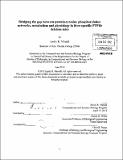Bridging the gap between protein-tyrosine phosphorylation networks, metabolism and physiology in liver-specific PTP1b deletion mice
Author(s)
Miraldi, Emily R. (Emily Rae)
DownloadFull printable version (16.96Mb)
Other Contributors
Massachusetts Institute of Technology. Computational and Systems Biology Program.
Advisor
Forest M. White.
Terms of use
Metadata
Show full item recordAbstract
Metabolic syndrome describes a complex set of obesity-related disorders that enhance diabetes, cardiovascular, and mortality risk. Studies of liver-specific protein-tyrosine phosphatase lb (PTPlb) deletion mice (L-PTPlb-/-) suggests that hepatic PTPlb inhibition would mitigate metabolic syndrome progression through amelioration of hepatic insulin resistance, endoplasmic reticulum stress, and whole-body lipid metabolism. However, the network alterations underlying these phenotypes are poorly understood. Mass spectrometry was used to quantitatively discover protein phosphotyrosine network changes in L-PTP lb-/- mice relative to control mice under both normal and high-fat diet conditions. A phosphosite set enrichment analysis was developed to identify numerous pathways exhibiting PTPlb- and diet-dependent phosphotyrosine regulation. Detection of PTP lb-dependent phosphotyrosine sites on lipid metabolic proteins initiated global lipidomics characterization of corresponding liver samples and revealed altered fatty acid and triglyceride metabolism in L-PTPlb-/- mice. Multivariate modeling techniques were developed to infer molecular dependencies between phosphosites and lipid metabolic changes, resulting in quantitatively predictive phenotypic models.
Description
Thesis (Ph. D.)--Massachusetts Institute of Technology, Computational and Systems Biology Program, 2012. Cataloged from PDF version of thesis. Includes bibliographical references.
Date issued
2012Department
Massachusetts Institute of Technology. Computational and Systems Biology ProgramPublisher
Massachusetts Institute of Technology
Keywords
Computational and Systems Biology Program.